#sehzade bayezid son of suleyman i
Explore tagged Tumblr posts
Text



This red and golden kaftan was first worn by Ayşe Sultan in the thirty-second episode of the fourth season of Magnificent Century.
It is seen again on Şehzade Mustafa (later Sultan Mustafa I) in the ninth episode of the first season of Magnificent Century: Kösem. The kaftan was also worn by Şehzade Süleyman (later Sultan Süleyman II) in the twenty-seventh episode of the second season.
#Muhteşem Yüzyıl#Muhteşem Yüzyıl: Kösem#Magnificent Century#Magnificent Century Kösem#Magnificent Century Kosem#period drama#costume drama#historical drama#Ayşe Sultan#Ayse Sultan#Ayşe Sultan (Daughter of Şehzade Bayezid)#Şehzade Mustafa#Sehzade Mustafa#Mustafa I#Şehzade Mustafa (Son of Halime)#Şehzade Süleyman#Sehzade Suleyman#Süleyman II#Şehzade Süleyman (Son of Dilaşub)#reused costumes#recycled costumes
8 notes
·
View notes
Photo








THE LIFE AND DEATH OF HÜRREM SULTAN | day 3: Hürrem and her children
There are no certain dates of birth for Hürrem's children, sometimes not even a specific year. Her first child, Şehzade Mehmed, was born in late 1521. In his case, only the year of his birth was recorded - 972 in Islamic calendar - which ended on 30 November 1521. Şehzade Mehmed was the first child of Süleyman I's to be born after his accession, around a year later, which could confirm the theory that Hürrem had been presented to him as a congratulatory gift. After Mehmed's birth, Hürrem's status rose, and in harem registers she started to be referred to as "the mother of Prince Mehmed". Her only daughter, Mihrimah, was born in autumn 1522, therefore breaking a centuries-old rule that mothers of a son could not have any more sexual encounters with the sultan. Süleyman was far from Istanbul at the time of the birth: he was at war against the Knights Hospitallers and returned to the capital only in February 1523. The future Selim II was born on 28 May 1524 - the only child to have a sure date of birth - and was followed in 1525 or 1526 by another prince, Şehzade Abdullah, who died of smallpox at a young age. Şehzade Bayezid was born in 1527, and Hürrem's youngest child - Şehzade Cihangir - was born in 1531, unusually distanced from his elder brother Bayezid. Peirce thinks he may have been "unanticipated or an afterthought—the result of a decision by Roxelana and Suleyman to have one last child", since his birth had arrived after the magnificent circumcision fest that Süleyman had organised for his three eldest princes, which could have symbolised that "the sultan considered his reproductive obligation to the empire fulfilled"
sources: Leslie Peirce, Empress of the East: How a European Slave Girl Became Queen of the Ottoman Empire; Leslie Peirce, The Imperial Harem: Women and Sovereignty in the Ottoman Empire
#history#historyedit#ottoman history#magnificent century#haseki hurrem sultan#mihrimah sultan#sehzade mehmed son of suleyman i#selim ii#sehzade bayezid son of suleyman i#sehzade abdullah son of suleyman i#sehzade cihangir son of suleyman i#ottomanladiesedit#hurremweek
793 notes
·
View notes
Note
So there is a high chance that suleyman and hurrem 's relationship wasn't monogamous right ? But if he really slept with other concubines then why and how didn't they give birth to children just like hurrem who gave him 5 or 6 children in a short period of time ? Also do you think that hurrem didn't sleep with suleyman after giving birth to her youngest sehzade since they didn't have another child for like 25 years+ ?
For this system and this culture I think we may safely call it monogamous. There’s nothing to indicate that he had any longer, even purely sexual, relationship with another woman. However, we obviously weren’t under his bed and since he had a harem full of women, we can’t be certain whether e.g. he didn’t quarrell with Hürrem once or twice and then had a one-night stand with one of the concubines for consolation… Even though Hürrem became his legal wife, there wasn’t a concept of marital fidelity there… And if he had any sexual encounters with any other women, he obviously most likely never produced any more children.
Here’s a quote from The Empress of the East by Leslie Peirce discussing the issue: (long, so under Read More)
Cihangir would be the last of Suleyman’s children. The sultan turned forty inAugust 1533, five months after he placed Mustafa in the field. The timing of the prince’s political inauguration was not coincidental. Forty was a number replete with religious, mythical, and historical significance for the Ottomans. For men, it was universally thought to be the threshold of full maturity. In Islamic tradition, the Prophet Muhammad was forty when he received the first of the revelations brought to him by the archangel Gabriel. In premodern times, the realities of the average person’s life span meant that a forty-year-old man was probably head of an extended family in which he and his wife were counting their own children’s children. Suleyman’s age was easy for his subjects to calculate if they remembered the year of his birth, 900, in the Islamic calendar. The beginning of a new Islamic century was thought to be a moment when a great leader might emerge.
Roxelana herself was still relatively young in 1533, probably in her late twenties at Cihangir’s birth two years earlier, almost certainly no more than thirty. But it would not be seemly to make a man who could now anticipate his first grandchild a father all over again. If decorum brought an end to her childbearing career, Roxelana may not have regretted leaving behind a phase of her life during almost half of which she had been pregnant. With five royal children to prepare for adulthood, she had her hands more than full. The end of childbearing did not spell the end of a sexual relationship between Roxelana and Suleyman, however. The sultan had apparently been unable to stay away from his favorite, and nothing suggests that their intimacy did not continue. And now it would be freed of the physical encumbrance of pregnancy.
But how did the couple keep from conceiving more children? It is fair to say that without the practice of birth control, the Ottoman sultanate could not have evolved the highly engineered politics of reproduction that it sustained. In the opinion of the majority of Muslim jurists, abortion in the first trimester was acceptable if the birth of a child would bring physical harm to the mother or hardship to the family. The Old Palace midwives and female doctors were doubtless experts not only in conception and childbirth but also in forms of birth control that were compatible with the needs of the imperial household.
A variety of abortifacients and contraceptive techniques were known and had been catalogued already in medieval times. Use of suppositories and tampons by females predominated. Among the prescriptions of Al-Razi were five for intravaginal suppositories that used oil from cabbage flowers, pepper, juice of peppermint, leaves of pennyroyal, and dill. Known to western tradition as Rhazes, the great Persian philosopher was also head of the Baghdad hospital, cutting-edge for its time, and a practicing physician. Roxelana herself was by now probably familiar with the palace’s recommended techniques, or so her slower rate of childbirth from 1526 on suggests.
Dynastic family planning was political planning. The personal decision of how many children to have and when was fraught with political consequence in the Ottoman dynastic family. Too many sons was a liability, as Suleyman had observed all too closely in the bitter rivalry between his uncles and his father. Even before their deadly showdown, he had watched Selim chafing at his confinement in Trabzon while his seven brothers and then their sons gained princely posts closer to the capital.
In 1533, Suleyman had four sons eligible to succeed him: Mustafa, Mehmed,Selim, and Bayezid. We can safely presume that Suleyman and Roxelanadeliberated the question of whether or not to have more children. Both wouldrecognize that the birth of yet another boy would only add more grief to thespectacle of their sons combating one another, let alone Mustafa. Four healthy sons was sufficient dynastic insurance, one more than Mehmed the Conqueror had provided. The public introduction of the three eldest princes at the 1530 circumcision celebration may have been intended in part to signal that the sultan considered his reproductive obligation to the empire fulfilled. A late baby, Cihangir was perhaps unanticipated or an afterthought — the result of a decision by Roxelana and Suleyman to have one last child.
- Joanna
It seems that Suleiman made a conscious decision not to have ANY more children, even with Hürrem. Still, judging by sources, I don’t think he had any long-term sexual relationship with any other woman.
#hurrem sultan#suleiman the magnficent#ottoman history#history#answered#anonymous#darlings I'm trying to be back#I closed inbox bc I need to finally answer all questions in inbox#it's for around a week#any urgent matters you may direct to our personal blogs or DMs or any other social media#it's just me wanting to start with a clean slate#have that comfort of mindset :)
42 notes
·
View notes
Text
The four Haseki and their relationship with beloved Mothers-in-Law

We'll come closer to the end of Kösem sultan and her magnificent story :,(. Now let me present these four ambitious hasekis in different time but lived below the same sky (don’t ask me why I included Ayşe, just keep reading it! ;-) and why I don’t include Hürrem vs Valide Ayşe Hafsa because mainly I forgot their story XP). Hürrem started this "opposing your mother-in-law" continued with Nurbanu to Turhan sultan (only in MY and MYK dear, not historically), but how their stories differ? Let's see...:
Afife Nurbanu Sultan:

Her mother-in-law was Hürrem sultan, Hürrem wanted her to be a smart but obedient daughter-in-law, she became a gozde (favorite) to sehzade Selim (later Selim II). Iirc, Nurbanu's conflict with Hürrem started when Hürrem refused to protect & defend her after she had fight with Hurichihan (Hatice sultan's daughter) & caused her death. Afraid to the consequence of her deed, she threatened Hürrem to show her letter about ordering Nurbanu to kill Suleyman I's other gozde, Nazenin hatun, from this onwards their conflict began. Other factor that driven Nurbanu is her ambition to support Selim to be the successor, next sultan after Suleyman I, especially after she found that Hürrem was supporting her other son, sehzade Bayezid. Her conflict with Hürrem mainly to prevent and foiled her to support Beyazid. Even after Hurrem's death, Nurbanu was still occupied with Beyazid's remaining supporters (including Mihrimah & Rustem->though Rustem would betray later via Gracia Mendes' seduction (LOL)).
Mahpeyker Kösem Sultan:
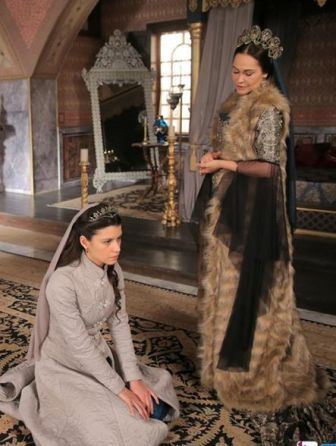
Her actual mother-in-law was Handan sultan, but her nemesis (in the show) was Safiye sultan, Handan's mother-in-law & the grandmother of Kosem's spouse Ahmed I. Similar with Hürrem, Safiye intended to present Kösem to Ahmed and use her to influence & control his power. Their conflict started when Safiye, unable to control Kösem anymore, decided to kill her father. Feeling betrayed, Kösem decided to avenge her father's death (while being a heroine too) by leading Safiye's daughter, Fahriye sultan to her death. Safiye repaid it with Yasemin hatun (Kösem's sister)'s death and Kösem paid it back with Iskender/sehzade Yahya (Safiye's missing son)'s death. Also Kösem being heroine wanted to protect Ahmed and the state from her, especially when Safiye did the coup d'etat, causing chaos in the palace. Not long after, Ahmed died, leaving Kösem with her little children fighting Safiye (and later Halime) alone.
Ayşe Sultan:
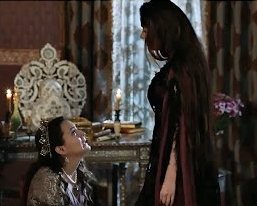
Her mother-in-law was Kösem sultan and her spouse was sultan Murad IV. Like Hürrem and Safiye, Kösem too expected that Ayşe would be an obedient, helpful & easily controlled by her. I think during the very first episode of season 2, there would be a rivalry and conflict between Ayşe and Kösem, how Ayşe said that she wished to support Murad and keep him away from the influence of his mother in ruling the state. Ayşe also said that she refused to follow every Kosem's orders and be obedient to her. Too bad this rivalry concept got thrown out and replaced with her fake rivalry with Farya as Mahidevran 2.0. Ayse's story here would be mainly fanon:
After Kösem's ten years regency, Murad became the sultan officially (I mean, the time when Murad was able to govern the state independently), but with Kösem's influence in the government, viziers & jannisaries, they were already familiar and support her and the people greatly trust her. Murad was struggling to gain the trust and recognition from his people. Everyone (including viziers and jannisaries) still doubted this young sultan's capability to rule, they always compared him to Kösem. Murad wanted to step out from his mother's shadow, he tried to limit Kosem's power and influence, he wanted his mother as valide sultan back to her initial duty, managing the harem. As loyal spouse and his most beloved woman, Ayşe supported Murad and helped him to be able to rule independently by trying to dispel and keep him away from his mother's influence, she also managed to seek the support from the people including some viziers. Ayşe chose to be a good wife and queen/haseki who supported her spouse the sultan in government rather than being used and controlled by his mother. Thus her conflict with Kösem sultan began. Besides her conflict with Kösem, Ayşe also had her own problem, she was struggling to provide Murad a healthy sehzade who would have his chance to survive adulthood and become the heir for Murad's throne. Murad's relationship with his mother was gradually strained. Seeing her son's insubordination to her, Kösem decided to get rid of Ayşe as the mastermind of the destruction of their family relationships. Their rivalry was fierce until Murad's death came. Ayşe who had lost her greatest support (and love) Murad and lost her sehzade who could be made an heir, lost her power, influence and purpose completely. She was immediately removed by Kösem and sent away to live in the Old Palace.
Turhan Hatice Sultan:
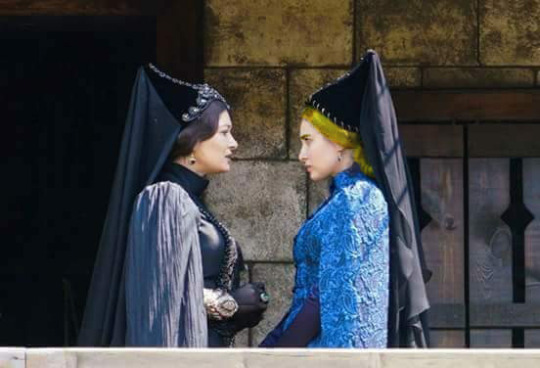
Her mother-in-law was also Kösem sultan and she was the spouse of Ibrahim I. Turhan had learned all the tales of the powerful sultana in Ottoman and had her own ambition. She saw Kösem as her role model and at the same time she wanted to be like her. Kösem still expected her to be easily controlled and obedient to her but Turhan thought that being obedient and passive won't make her a powerful figure. She found that to fight her mother-in-law, she had to get her sultan's support. Observing her situation and circumstance, getting the support from her spouse seemed difficult since Ibrahim had numerous gozde that he loved, he even appointed his eight gozde (including her) as his haseki. Turhan could become the Baş Haseki had been a lucky one for her since she had Ibrahim's oldest sehzade Mehmed. The odds of getting support from her spouse are getting smaller as he brought new gozde again and this gozde became his legal wife (Telli Humaşah). Thus, rather than wage an open war to Kösem, she decided to gain the trust for her. By being the closest person to Kösem, she could observe everything, from how Kösem gains her supports to find a chance to overthrow her. During this time, Turhan managed to gain the trust of viziers, but Kösem still had the most influence in jannisaries. Turhan also tried her best to secure her son and protect him as the next heir after Ibrahim's death. When Ibrahim died, Mehmed the oldest sehzade succeeded him. But as long as Kösem still alive, her struggle was not over yet. Kösem who had many experience as regent thought that inexperienced Turhan wasn't competent enough to rule the state, Kösem was preventing her to be in charge of state affairs. Turhan disagreed since she felt entitled as the mother of Mehmed IV. Kösem later went to far by attempting to remove Mehmed and replaced him with sehzade Suleyman (the son of supposedly more obedient haseki Saliha Dilasub). Driven by her will to protect her son's life, Turhan decided to get rid Kösem completely and her men successfully murdered her. Eventually, Turhan became regent and rule the state together with her son. My fanon is that the previous haseki sultan Ayşe wanted have her revenge with Kösem, so she temporarily helped Turhan behind the scene.
Summary:
Many young sultana during their time as queen consort (haseki) had strained relationship with her mother-in-law, the queen dowager (valide sultan), they had similar ambitions but they had their different motivation and situation.
In Nurbanu's case, she was a favorite of Selim II during his sehzade years. There was sehzade Beyazid as threat who challenged Selim's way to be the heir. Being supportive to her spouse, Nurbanu made sure that Selim will success it. Nurbanu's main focused was how Selim would take the throne.
In Kösem's case, she initially was driven by revenge. But later when she found that Ahmed I her spouse's life was also in danger, she fought to protect him. Safiye's failed attempt to control Ahmed drove her to led a coup d'etat. Ahmed with the help of Kösem successfully weakened Safiye's power and influence. But not long after that, Ahmed died and Kösem lost her greatest support. Kösem became alone surrounded with many dangerous snakes especially Safiye and Halime, though in the end she was able to get rid of them.
In Ayse's case, Murad became a sultan who just been deemed worthy to rule by his own. Ayşe helped Murad to gain the trust and to be recognized by his people, she wanted him to get out from Kösem's shadow. Ayşe also had another burden since Murad didn't have an apparent heir yet. In the end Murad died without heir and his brother Ibrahim was the one who succeeded him. Ayşe lost her position and had to spend her life in the Old Palace according to the custom.
In Turhan's case and during her time, Ibrahim I had his eight harem girls as the haseki. Turhan happened to bore him the oldest sehzade Mehmed thus she became the Baş haseki. Turhan had to face her many harem rivals including the greatest threat who was Telli Humaşah, the girl Ibrahim brought and became his legal wife. Turhan was not really loved by Ibrahim (as she was not his most favorite). After Ibrahim's death, Turhan had her power struggle with Kösem sultan. She wanted to be regent ruling independently but her reign always overshadowed by Kösem. Their conflict became worse when Kösem wanted to get rid of Turhan's son and replaced him with her other grandson, thus leading to Kosem's death by Turhan's men hands.
TL;DR
All had their conflict with their MiLs but Nurbanu was haseki of sehzade whereas Kösem, Ayşe and Turhan were haseki of sultans. All supposedly outlived their MiL but canon MYK!Ayşe died before Kösem. Although Kösem had her conflict with her actual MiL Handan, her main nemesis was Safiye sultan, her MiL's MiL (or should I say grandmother-in-law). Nurbanu's spouse Selim I outlived his mother but Ahmed I (Kosem's spouse), Murad IV (Ayse's spouse) and Ibrahim I (Turhan's spouse) died before their mothers (and grandmother in Ahmed's case). Nurbanu, Kösem and Turhan had their surviving sons took his fathers' throne whereas Ayşe didn't. Nurbanu, Kösem and Ayşe were loved and greatly supported by their spouses whereas Turhan was not really (but canon-MYK!Ayşe instead was greatly abused and hated by him), Ibrahim might loved Turhan but she was not his most beloved one. Nurbanu, Kösem and Turhan succeeded in becoming valide sultan and became the most powerful sultana in their respective era whereas only Ayşe who couldn’t make it since she didn’t have a sehzade (the prince), the most important asset for every women as royals.
Conclusion:
Powerful and ambitious women in MY and MYK always expect their daughters-in-law to be the obedient and easily-controlled. Unbeknownst for them, they became the role models of their younger generations. Thus, instead having the obedient DiL, they got their own reflection: the DiL that exactly the same with their younger selves. These DiL won’t easily submit to them just like themselves in their younger days.
Also I wonder when Turhan’s hair color was mentioned as blonde, There is no popular culture that show Turhan with blonde hair. Mahpeyker: Kösem Sultan’s Turhan was brunette and Muhteşem Yüzyıl: Kösem‘s Turhan is dark haired (likely black). I’m sorry with my shitty bad quality editing but I want my Turhan’s blonde XD, I’m not expert.
#valide sultan#haseki sultan#muhtesem yuzyil#muhtesem yuzyil kosem#my thoughts#mother in law vs daughter in law#ottoman empire#hurrem sultan#nurbanu sultan#safiye sultan#kosem sultan#ayse haseki sultan#turhan hatice sultan#haseki ayse sultan's story is mainly fanon#canon!MYK story gave Ayse's story & character injustice#canon!MYK is not historically canon either#respect haseki ayse post#blonde!Turhan
25 notes
·
View notes
Note
Hello, thank you for your good blog
Why was Prince Beyazid not buried in Bursa? I read somewhere that Suleiman ordered him to be taken to Istanbul but was suddenly buried in Sivas.
Peirce says that Bayezid and his sons were denied a burial place in Bursa, presumably by Süleyman himself:
Bayezid and his sons were interred outside the walls of Sivas, an eastern Anatolian provincial capital. The site was presumably chosen to avoid a train of coffins traveling across Anatolia that could rekindle partisan agitation. — Empress of the East: How a European Slave Girl Became Queen of the Ottoman Empire
I really doubt that Süleyman had asked for Bayezid's body to be taken back to Istanbul, as he had died a rebel.
Princes were usually buried in Bursa but Süleyman broke tradition only for his sons who had died of natural causes: Mehmed and Cihangir. Not only were they buried in Istanbul but mosques in their names were erected.
Mustafa — another rebel — was buried in Bursa as it was customary to do but without a mausoleum until Selim II paid for it.
Bayezid's situation was different from Mustafa's too in that he had sought refuge at the Shah of Persia's court. To get him back, Süleyman had had to pay the Shah:
The sultan was forced to pay the shah a steep price to recover his wayward prince: the fortress of Kars on the Ottoman-Armenian border and 1.2 million gold florins. — Empress of the East: How a European Slave Girl Became Queen of the Ottoman Empire
I don't think Süleyman was in the mood to ask for his body to be taken back to Istanbul, to be honest. I think his burial in Sivas was dictated also by irritation.
16 notes
·
View notes
Note
Do you think Bayezid would still be executed if Hurrem outlived Suleiman? If Sulieman passed while Bayezid and his sons were still sheltered by the Safavids, what goes down? Does whether Hurrem is alive or not really change things at all for Selim and Bayezid? thanks!
I honestly have no idea and I'm not even good at imagining these things. I don't think that in the end she could have saved any of her sons from fratricide... Mustafa I was saved because the new sultan was a boy with no sons; Selim II was in his 40s and with a son already. There was no reason to "preserve" another prince. Also, seeing as Bayezid had been a thorn to Selim's side, Hürrem could have never saved him. I think she could have tried to make him come back to Istanbul (instead of being executed right away) but I’m not sure he could have saved his life.
Hürrem was powerful but not this powerful... though I also think that she would have understood that keeping Bayezid alive would have made things awful for Selim. I mean, imagine Selim's rocky enthronement but with Bayezid alive??? It would have been a disaster. I even doubt that he would have been able to take possession of Topkapi.
14 notes
·
View notes
Text
Yeah Plami did an excellent analysis as always <3, to resume, I don't think that Hurrem showed to the funeral to be disrespectful, but it ended being like that, just like Suleyman going to Mustafa's tomb they had to know that his mother -and family, in Hurrem's case- wouldn't like to see the murderer of her son & wouldn't restrain herself from screaming at her, comming with her typical darwinist justifications to defend herself was... The next level to disrespectful honestly.
About the "want you to be my son" scene, I think this scene wouldn't have happened if Mustafa didn't saved Selim, I feel that Hurrem was speaking because she felt genuinely in debt to him but at the same needing to justify her own past (&next) actions, and as I said: Hurrem is full of excuses for her bad deeds, she •makes mustafa seem like this villain who's tricking his siblings & dad •makes him -as this scene- & herself the victims of a game that are obligated to be against each other (that while yes, there's the fatih law & she believes that Mustafa becoming sultan would in some way or another kill her sons, she's pretty much the one that chose to represent this system of the one that defeats everyone wins from the start, including Mustafa in her list from S2 when he was still a young teenager, so she really never intended to see it in other way, and the worst part is that by excusing herself & Suleyman by this system, all she does is pass her philosofy through her sons.... And we see how this goes on that even Mihrimah supports Bayezid to kill Selim, in Hurrem wanting herself & her kids to succeed over everyone because they're stronger she ended propagating the system that ended killing one of her sons & her grandchildren, and having such influence in everyone's destinies, just imagine what could've happened if she had chosen to fight the system instead of perpetuate it!), despite Mustafa never attacked / nor felt the obligation to attack his siblings • and just as in the funeral scene, merges those both excuses to make him this arrogant weak sehzade that had to be defeated for someone stronger.
So honestly, I feel like the reason for which many of her fans don't see Mustafa's death as a tragedy is more for listening to her excuses as the whole truth than for not listening what she says, which just shows how many blind fanatism this woman gets instead of critical watchers that like her character as a whole, not as this darwinist winner over boring weak characters image that she created of herself.
#LeaveMustafaAlone2k21
82 notes
·
View notes
Photo
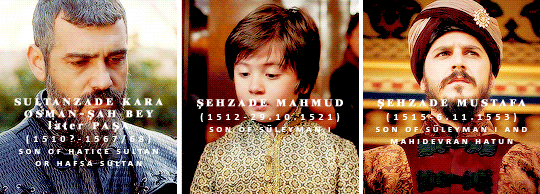

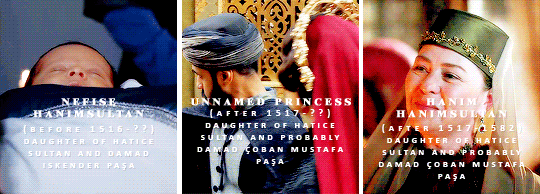

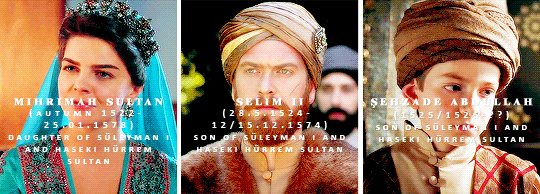

OTTOMANLADIES’ 2ND BIRTHDAY CELEBRATIONS
Ayşe Hafsa Sultan + known grandchildren -- requested by anon
#history#historyedit#ottoman history#ayse hafsa sultan#hatice sultan daughter of selim i#beyhan sultan daughter of selim i#suleyman i#sehzade mustafa son of suleyman i#mihrimah sultan#sehzade mehmed son of suleyman i#selim ii#sehzade bayezid son of suleyman i#sehzade cihangir son of suleyman i#ottomanladiesedit#*requested
624 notes
·
View notes
Note
Is it true that Suleiman wrote poems under the name Muhibbi? Did he write any for Hurrem or his children or other people? Is there a diwan of it? Was it common for Sultans to write poetry? Were concubines or daughters educated like that- to compose poetry or play instruments?
I don't want to sound rude but if you google Muhibbi Süleyman the Magnificent comes up. And it seems to me that if you know what a divan is, then you also know the answer to your own questions (and if you don't: I assure you the first google result of "Suleyman the Magnificent poet" is a link to buy a selection of his works). Lastly, this is a blog about women and I am contemplating whether to stop answering asks about men or not.
In any case
Süleyman was a great poet, as Talat S. Helman says:
Divan poetry, as the Turkish elite poetry that was influenced by Arabic and Persian literature is often called, found favor at the court and at the coffeehouse, satisfying the aesthetic needs of both the elite and the man in the street. Significantly, two-thirds of the sultans were poets—some, in particular Mehmed “the Conqueror” (1432–81) and Süleyman the Magnificent (1494–1566), were first rate.
His poems were mostly about love:
Kanuni Süleyman (better known in the West as Süleyman the Magnificent), like many other sultan-poets, including Selim I, Ahmed I, Mustafa III, and Selim III, denigrated worldly power, choosing to glorify the supremacy of love: What they call reigning is nothing but worldly quarrel; There is no greater throne on the earth than the love of God
The one he penned for Hürrem is quite famous (and was sent to her as a letter):
My very own queen, my everything, my beloved, my bright moon; My intimate companion, my one and all, sovereign of all beauties, my sultan. My life, the gift I own, my be-all, my elixir of Paradise, my Eden, My spring, my joy, my glittering day, my exquisite one who smiles on and on. My sheer delight, my revelry, my feast, my torch, my sunshine, my sun in heaven; My orange, my pomegranate, the flaming candle that lights up my pavilion. My plant, my candy, my treasure who gives no sorrow but the world’s purest pleasure; Dearest, my turtledove, my all, the ruler of my heart’s Egyptian dominion. My Istanbul, my Karaman, and all the Anatolian lands that are mine; My Bedakhshan and my Kipchak territories, my Baghdad and my Khorasan. My darling with that lovely hair, brows curved like a bow, eyes that ravish: I am ill. If I die, yours is the guilt. Help, I beg you, my love from a different religion. I am at your door to glorify you. Singing your praises, I go on and on: My heart is filled with sorrow, my eyes with tears. I am the Lover—this joy is mine. Muhibbi (Sultan Süleyman’s pen name), sixteenth century
These are other poems that Halman translated in English:
I am the Sultan of Love: a glass of wine will do for a crown on my head, and the brigade of my sigh might well serve as the dragon's fire-breathing troops. This bedroom that's best for you, my love, is a bed of roses, for me, a bed and a pillow carved out of rock will do. My love, take a golden cup in your hand and drink wine in the rose-garden; as for me, to sip blood from my heart, it is enough to have the goblets of your eyes. If, my beloved, you ride the horse of coyness and trot in the polo grounds, this head of mine will do as a ball for your mallet. Come, don't let the army of sorrow crush the heart's soldiers; if it is my life you demand just send those looks of yours— that should be enough. The heart can no longer reach the district where you live, but it yearns for reunion with you: don't think Paradise and its rivers can satisfy the lover of the adorable face. Lover, I have enough tears to sprinkle over the ground you walk on— and my own pallid face will do for me as silver and gold.
Listen, my heart, don't crave silver and gold like a highwayman; Don't spruce yourself up with satin and trinkets like a woman... Don't stand there, stiff, chest puffed up, like a wrestler's lion. Never cherish wealth or high office. Don't brag: "I'm better than anyone!" Others have their own rights: Don't stick out your tongue at them like an iris. You might conquer far-flung lands and seas and rule them as their sovereign king: Even if your reign on the imperial throne becomes everlasting. Don't be taken in: One day, a hostile wind is bound to blow and bring To your land of beauty heaven's misfortune and worst suffering. Don't blow up your chest like a proud sail; shun arrogance and malice.
Friends, in my eyes, life has no meaning without the loved one; To the nightingale, the world is a cage if it has no rose-garden. I languish on sorrow's mountain where night and day I sigh and moan: Wondering what fate awaits me with my beloved gone. Beware the consuming fire of my groan, for you are a tender sapling. My bosom is engulfed in flames that will rage if I cannot find my darling. What good is her province to me if I am not to see her? This Lover will not accept Paradise without the loved one.
This one was written for Bayezid and I thought it was very interesting:
Oh you! There were times you engaged in tumultuous rebellion, my son; You did not carry around your neck the pendant of ferman, my son. Oh, would I ever put you in death's throes, my own Bayezid Khan, my son? But at least don't say "I am without guilt." Repent, my dearest one, my son.
As Halman says in his introduction to Süleyman the Magnificent Poet: The Sultan's Selected Poems, Süleyman mostly wrote about love and private matters.
Concubines and daughters were not educated to write poetry. Indeed, there are very few of them:
Afife Hatun (or Kadın) was a consort of Mehmed IV who used to exchange verses with him and who also wrote a poem about Emetullah Rabia Gulnus pining inside the Old Palace after his deposition
Adile Sultan was a daughter of Mahmud II known as the only Ottoman princess who composed poems.
Musical instruments were another thing entirely.
Angiolello, who lived as a page in Mehmed II's palace said about this:
"[T]he most senior [women[, who are trained, teach the new and unrefined to speak and read and instruct them in the Muhammadan law, and also teach them to sew and embroider, and to play the harp and to sing, and instruct them in all their ceremonies and customs, to the degree that [these girls] have the inclination to learn." — Leslie P. Peirce, The Imperial Harem: Women and Sovereignty in the Ottoman Empire
Women who made their way up the harem hierarchy by appointment to the training/service divisions or to the suites of high-ranking family or household staff members presumably spent their time acquiring and perfecting the skills and manners appropriate to their new station. Those who showed an aptitude for instrumental music, singing, or dance were trained in these arts. The valide sultan selected the most talented and beautiful of these more highly trained women for her own suite. — Leslie P. Peirce, The Imperial Harem: Women and Sovereignty in the Ottoman Empire
#anon#ask post#ask: ottoman history#suleyman i#sehzade bayezid son of suleyman i#haseki hurrem sultan#afife kadin#adile sultan daughter of mahmud ii#Anonymous
52 notes
·
View notes
Note
Hi, why did you mean when you said "hurrem saved bayezid once while she was alive" ?
It happened when Bayezid failed (or so his father believed) to quickly sedate the revolt of the Pseudo Mustafa. This is the entire episode as told by Busbecq:
Busbecq had recently returned to Istanbul with new treaty terms Suleyman had demanded from Ferdinand, and his correspondent was eager for news of Bayezid. The ambassador opened his letter by announcing that great changes had taken place. The first item of news was that the prince “had freed himself from serious danger and was reconciled to his father.” Roxelana, he wrote, had rescued her son by placating Suleyman. Taking considerable license in ascribing to Roxelana words presumably spoken in private, Busbecq wrote, “His wife, with her usual cleverness, easily read his thoughts. Letting a few days elapse in order that his wrath might die down, she touched upon the subject in the Sultan’s presence.” Having “quoted similar incidents from the past history of Turkey,” Roxelana pointed out that protecting oneself and one’s family was a natural instinct in all men, that every man wanted to avoid death, and that evil counselors could easily lead young men astray. (This was doubtless an allusion to the terrible exigencies of the succession system.) “It was only fair, she said, to pardon a first offence; and if his son amended his ways, his father would have gained much by sparing his son’s life; if, on the other hand, he returned to his evil ways, there would be ample opportunity to punish him for both his offences. She entreated Suleyman, if he would not have mercy on his son, to take pity on a mother’s prayers on behalf of her own child.”43 Busbecq imagined Roxelana adding “tears and caresses” and Suleyman “softening,” but he perhaps wrote more realistically regarding Suleyman’s long lecture to Bayezid on his errors before pardoning him. Peace made, Bayezid’s governorship was transferred from Konya to Kütahya in northwest Anatolia, undoubtedly a victory for Roxelana. Now both princes were roughly equidistant from Istanbul. -- Peirce, Leslie. Empress of the East: How a European Slave Girl Became Queen of the Ottoman Empire
#anon#ask post#ask: ottoman history#haseki hurrem sultan#sehzade bayezid son of suleyman i#suleyman i#Anonymous
20 notes
·
View notes
Note
This is probably a dumb question but do you think Bayezid might have taken the throne if Nurbanu had been his concubine instead of Selim’s?
No, I don’t think Nurbanu’s presence guaranteed Selim II’s success. While in MC it is somehow inferred that she is a way better concubine than Defne or Huricihan (though she wasn’t really a consort but whatever), it has no historical basis.
Had Nurbanu been Bayezid’s consort, she would have seen her children be executed for treason.
#anon#ask post#ask: ottoman history#ask: magnificent century#nurbanu sultan#sehzade bayezid son of suleyman i#Anonymous
18 notes
·
View notes
Note
Were any of Mustafa or Bayezid’s sons appointed governors like Murad was?
In 1558, Süleyman made governors his eldest grandsons: Murad was appointed governor of Akşehir, Bayezid's son Şehzade Orhan was appointed governor of Çorum.
According to Öztuna, a year later, Süleyman appointed Bayezid's second son, Şehzade Osman, governor of Karahişâr-ı Şarkî (later, he was made governor of Cânik). Bayezid's fourth son too was appointed governor in 1559: Şehzade Mahmud, to Cânik. It is not clear why Şehzade Abdullah, Bayezid's third son, wasn't given a province.
As Mustafa had been executed in 1553, and his son a month later, he was never appointed governor.
#anon#ask post#ask: ottoman history#murad iii#sehzade mustafa son of suleyman i#sehzade bayezid son of suleyman i#Anonymous
10 notes
·
View notes
Note
It’s interesting how MC implied Selim and Bayezid would be monogamous when historically they weren’t meanwhile their father Suleiman who is famous for being devoted to Hurrem had several affairs
Well, Selim kind of was in his princely years, but yeah, Bayezid’s sons all had different mothers. In this regard, Mustafa was more accurately portrayed, with his three (?) consorts, though at different stages of his life.
#anon#ask post#ask: ottoman history#ask: magnificent century#selim ii#sehzade bayezid son of suleyman i#sehzade mustafa son of suleyman i#Anonymous
10 notes
·
View notes
Note
I'd like to ask your opinion about Şh. Bayezid's child. Even reliable sources gave that his first son Orhan was born around 1543, which is impossible as Bayezid became governor of Konya in 1546. If he was born in 1546 then, how and why he bacame governor in 1558 just 12-13 years old? Isn't it strange? Is it possible Bayezid was asigned to Konya earlier or he maybe could have consorts before having province? Maybe during the 1543 campaign where he accomponied Suleyman he may had a concubine?
Regardless of Şehzade Orhan's year of birth, which is not established with certainty, 12-13 years old was an appropriate age to become governor of a province. In this Süleyman was following his predecessors' steps.
In 1412 the young sultan Mehmed I, fighting to reintegrate the empire after the debacle wreaked by Timur, assigned his twelve-year-old son Murad to Amasya, and a year later ordered the young prince, with the help of a trusted military commander, to quell a politico-religious rebellion that had already defeated one army sent against it. — Leslie P. Peirce, The Imperial Harem: Women and Sovereignty in the Ottoman Empire
Giovanni Maria Angiolello, part of Şehzade Mustafa (Mehmed II's son)'s retinue said:
When one of [the maidens] becomes pregnant by the Monarch, her salary is increased and she is honored and elevated above the others, and is served as a Lady. And if she gives birth to a son, the boy is raised by his mother until the age of 10 or 11; then the Grand Turk gives him it sanjak [a province] and sends his mother with him.... — Leslie P. Peirce, The Imperial Harem: Women and Sovereignty in the Ottoman Empire
Indeed, we know that Murad III - born exactly in 1546 - became governor of a province in 1558, at the age of 12:
When Selim came to the throne, his son Murad, twenty years old, had held the post of provincial governor for eight years. (In 1558 Süleyman had assigned signed provincial posts to two grandsons, Murad and Bavezid's son Orhan, both of whom were about twelve years old [...] The grandsons' posts were close to those of their fathers: Orhan went to Çorum at the same time his father was transferred to Amasya, and Murad went to Akşehir when his father was transferred to Konya. — Leslie P. Peirce, The Imperial Harem: Women and Sovereignty in the Ottoman Empire
In this quote, Peirce also seems to be believe that the two grandsons were around the same age, so it is possible that Şehzade Orhan was born in 1546 after all.
I don't believe Bayezid had consorts earlier than his dispatch to Konya or that he fathered a child during a military campaign. Peirce says in Empress of the East, that Bayezid became governor of Konya in 1546, which makes sense because at that time Selim had already been transferred to Manisa because of Şehzade Mehmed's death.
On the other hand, Öztuna says that he became governor in 1941:
governor of Karamân (Konya) and then of Germiyân (Kütahya) 18.6.1541 – 2.12.1558
The problem with this claim is that he gives the same date for when Selim became governor of Konya, which is... confusing:
governor of Konya 18.6.1541 – 6.11.1543
In any case, Peirce's date seems more probable: not only because Selim was governor of Konya from 1541 until 1543 (when he was given Manisa), but because as she says in Empress of the East, Bayezid had always been paired with Cihangir - they were also circumcised together - so it makes no sense for him to "graduate" with Selim and Mehmed.
#ask post#ask: ottoman history#sehzade bayezid son of suleyman i#sehzade orhan son of sehzade bayezid#selim ii#murad iii#reallifesultanas
15 notes
·
View notes
Note
Can you give me some information about Sehzade Bayazid's daughters? When did they get married? Did one of Prince Bayazid's daughters married Ahmad Pasha's in 1566? What do you know about their spouses? Oztuna claims that Ayse Sultan, Bayazid's daughter, married Ali Pasha. This girl is buried in Ayub Sultan Mosque. She is mentioned on her grave as Ghazanfar Pasha's wife.
I have talked about Bayezid’s daughters here and this is everything I know about them.
3 notes
·
View notes
Photo
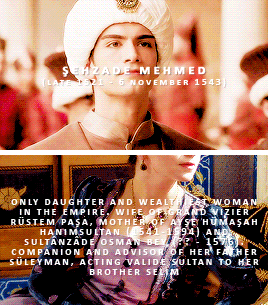






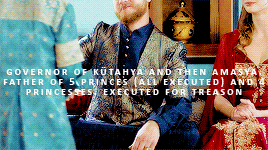


Haseki Hürrem Sultan + children // sources: Leslie Peirce - Empress of the East, Yılmaz Öztuna - Kanuni Sultan Süleyman
#history#historyedit#magnificent century#haseki hurrem sultan#sehzade mehmed son of suleyman i#mihrimah sultan#selim ii#sehzade abdullah son of suleyman i#sehzade bayezid son of suleyman i#sehzade cihangir son of suleyman i#ottomanladiesedit#childrenof
2K notes
·
View notes